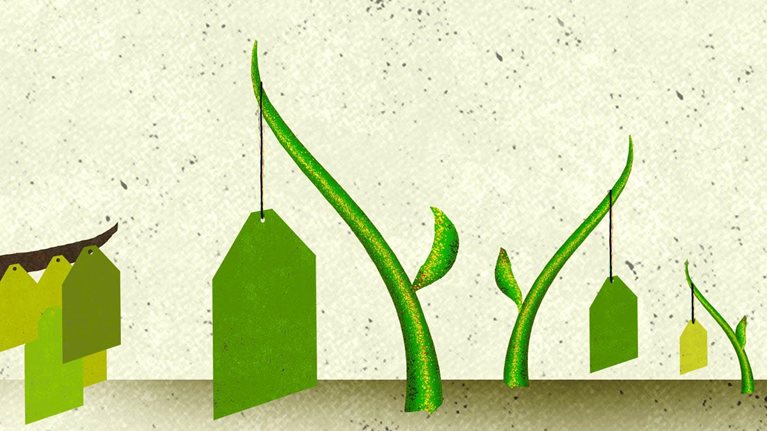When it comes to price-to-earnings ratios, most executives understand that a high multiple enhances a company’s strategic freedom. Among other benefits, strong multiples can provide more muscle to pursue acquisitions or cut the cost of raising equity capital. Unfortunately, in their efforts to increase their P/E, many executives reflexively try to crank up growth. Too many fail to appreciate the important role that returns on capital play in channeling growth into a high or low multiple.
Simply put, growth rates and multiples don’t move in lockstep. For instance, the retailer Williams-Sonoma has a P/E multiple of about 21, based on earnings growth over 15 percent in the past three to five years and low returns on capital.1 By contrast, Coca-Cola has a slightly stronger P/E at 24, despite its lower growth rate.2 Coke’s secret? Returns on capital over 45 percent relative to a 9 percent weighted average cost of capital.
It’s common sense: growth requires investment, and if the investment doesn’t yield an adequate return over the cost of capital, it won’t create shareholder value. That means no boost to share price and no increase in the P/E multiple. Executives who do not pay attention to both growth and returns on capital run the risk of achieving their growth objectives but leaving behind the benefits of a higher P/E and, more important, not creating value for shareholders. They may also discover that they have confused their portfolio and investment strategies by treating some high-P/E businesses as attractive growth platforms when they are actually high-returning mature businesses with few growth prospects.3 Better understanding of the way growth and returns on capital combine to shape each business’s multiple can produce both better growth and better investment decisions.
Doing the math on multiples
The relationship between P/E multiples and growth is basic arithmetic:4 high multiples can result from high returns on capital in average or low-growth businesses just as easily as they can result from high growth. But beware: any amount of growth at low returns on capital will not lead to a high P/E, because such growth does not create shareholder value.
To illustrate, consider two companies with identical P/E multiples of 17 but with different mechanisms for creating value (Exhibit 1). Growth, Inc., is expected to grow at an average annual rate of 13 percent over the next ten years, while generating a 14 percent return on invested capital (ROIC), which is modestly higher than its 10 percent cost of capital. To sustain that level of growth, it must reinvest 93 cents from each dollar of income (Exhibit 2). The relatively high reinvestment rate means that Growth, Inc., turns only a small amount of earnings growth into free cash flow growth. Many companies fit this growth profile, including some that need to reinvest more than 100 percent of their earnings to support their growth rate. In contrast, Returns, Inc., is expected to grow at only 5 percent per year, a rate similar to long-term nominal GDP growth in the United States.5 Unlike Growth, Inc., however, Returns, Inc., invests its capital extremely efficiently. With a return on capital of 35 percent, it needs to reinvest only 14 cents of each dollar to sustain its growth. As its earnings grow, Returns, Inc., methodically turns them into free cash flow.
Companies can have identical P/E multiples for dramatically different reasons.

Sustaining high growth requires considerably more reinvestment than sustaining high returns.

Because Growth, Inc., and Returns, Inc., take very different routes to the same P/E multiple, it would make sense for a savvy executive to pursue different growth and investment strategies to increase each business’s P/E. Obviously, the rare company that can combine high growth with high returns on capital should enjoy extremely high multiples.
The hard part: Disaggregating multiples
Not many executives and analysts work to discern how much of a company’s current value can be attributed to expected growth or to returns on capital. Those who try often fail. To see why, consider one widely used model to break down multiples as it might be applied to a large consumer goods manufacturer and a fast-growing retailer with similar P/E ratios (Exhibit 3).
Traditional assessments of enterprise value can lead to a misinterpretation of where value comes from.

The first step is to estimate the value of current earnings in perpetuity, assuming no growth.6 The model then attributes the remaining value to growth. The interpretation from this simple two-part approach would be that the market assumes that the consumer goods manufacturer would have better growth prospects than the retailer.
But this reading misleads because it doesn’t take into account returns on capital. Discount retailers fight it out primarily on price, which translates into lower margins and relatively low returns on capital—similar to Growth, Inc. In contrast, consumer goods companies compete in an environment where brand equity can generate higher margins and returns on capital, making them more like Returns, Inc. In fact, the simple two-part model is wrong. The discount retailer is actually expected to grow faster and to create more value from growth than the consumer goods company, whose high valuation would be primarily based on high returns on capital.
An executive relying on the faulty analysis produced by such a simple model might flirt with trouble. The CEO of the consumer-goods company might increase investment or discount prices to drive growth, potentially destroying shareholder value in the long run. By digging a little deeper and appreciating the role of returns on capital, the CEO would more likely focus on protecting high returns and market share.
Accounting for the ROIC premium
How can we avoid these misinterpretations and still keep the analysis relatively simple? In our experience, the best way to understand the respective roles of returns on capital and growth in shaping a company’s P/E is to expand the simple two-part model and draw out a P/E premium for high returns on invested capital. This approach effectively disaggregates value into three easily understood parts:
Current performance. Current performance is still estimated in the usual manner, as the value of current after-tax operating earnings in perpetuity, assuming no growth. Intuitively, this is the value of simply maintaining the investments the company has already made.
Return premium. This is the value a company delivers by earning superior returns on its growth capital. In order to assess how a company’s return on growth capital influences its P/E multiple, we recommend discounting a company’s cash flows as if they grew in perpetuity at some normalized rate, such as nominal GDP growth.7 Through repeated analyses, we have found that the result is a good proxy for the premium a company enjoys in the capital markets because of its high returns on future growth capital. In our example, the consumer goods manufacturer would enjoy a large return premium, consistent with its high historical returns on capital.
Value from growth. This value represents how much a company delivers by growing over and above nominal GDP growth. It can be calculated as that portion of the company’s current market value that is not captured in current performance or the return premium.8 While more sophisticated and time-consuming analyses are sometimes appropriate, in our experience executives can learn a lot about their P/E multiple with this simple three-part model.
How might an executive change his or her insights about the consumer goods company and the discount retailer using this three-part model? The consumer goods company would be seen to enjoy a large premium for its return on capital. In the consumer goods sector, preserving that return premium must be paramount, but anything the company can do to increase its organic growth rate while preserving its return premium would translate directly into shareholder value and the possibility of a very high multiple.
In contrast, the CEO of the discount retailer would face a tiny premium for return on capital, since his or her company derives most of its value from the rapid growth prospects. Anything this company could do to increase its ROIC, possibly even reining in its growth rate, would add value. By applying the model to calibrate the trade-off between growth and return, the CEO could even determine that a top management priority is to redirect some attention from growth to operations improvement.
High P/E multiples can serve as a powerful strategic tool. Executives who understand the complex chemistry of growth, returns, and P/E multiples will be better positioned to make strategic and operating decisions that increase shareholder value.


